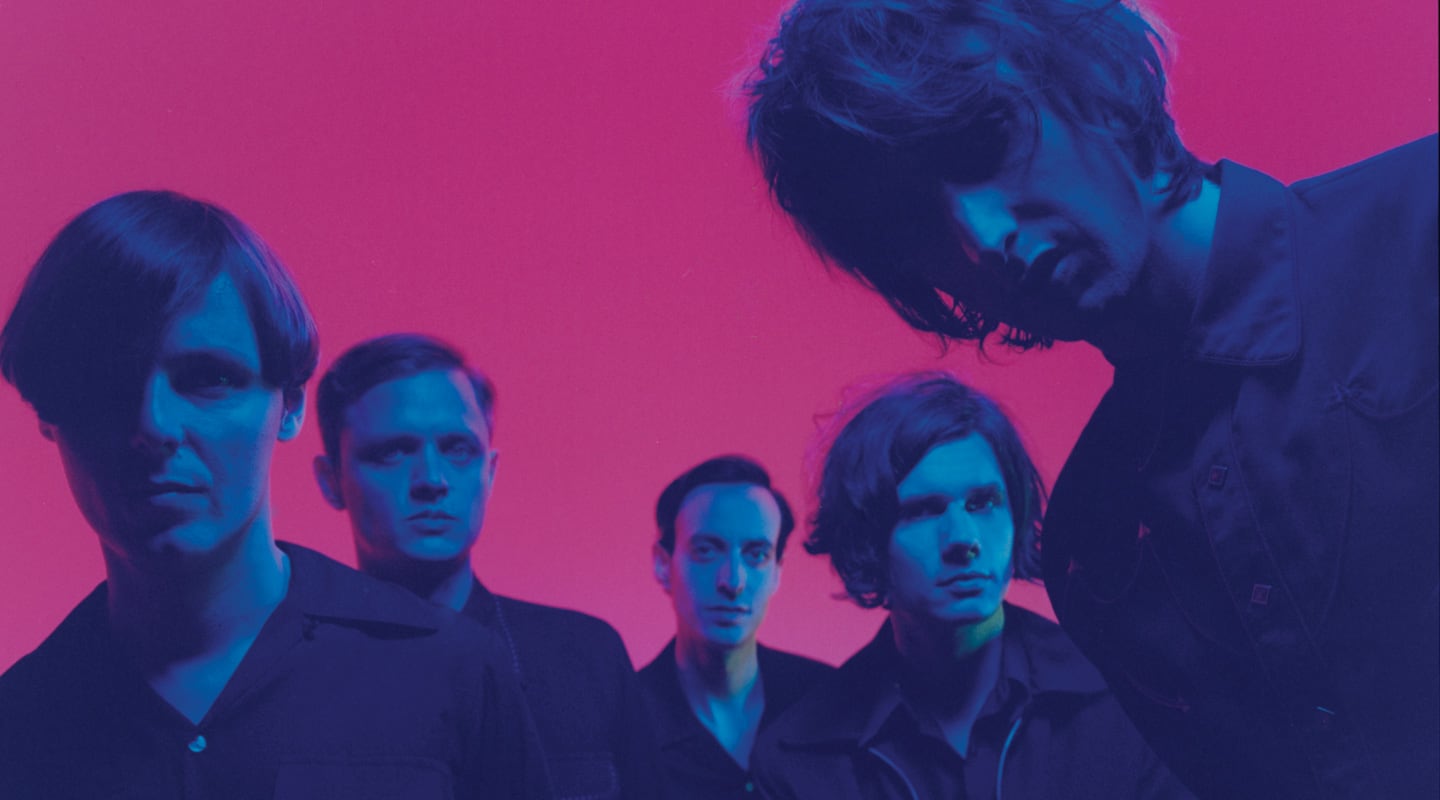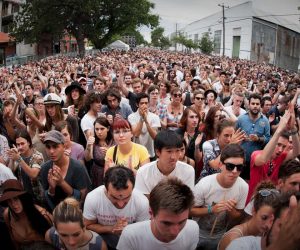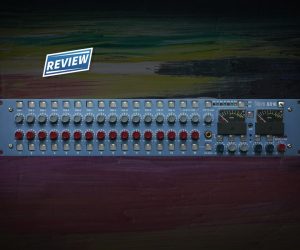
Horrors Find Sanctuary
After two albums toiling away in their gloomy East London studio, UK band The Horrors renew their spirits at The Church under the counsel of Paul Epworth.

Artist: The Horrors
Album: V
The DIY route’s appeal is in its affordability. That all goes out the window when you’re paying East London rents on a ‘home’ studio.
UK goth rockers-turned-electronic post punk darlings The Horrors, had diligently plowed away in their own studio for five years, when “we had a look at the total amount of rent paid over the years and it was this huge number!” keyboardist Tom Furse explained. “It was insane.”
The band had built the studio in the bones of an old loading dock with the express purpose of recording their third album themselves. Their debut, Strange House — produced and mixed by an array of UK greats including Alan Moulder and Ben Hillier — had been pretty straightforward garage rock with a goth-punk edge. At the time, Furse was almost exclusively pumping out horror-movie licks on an organ. Their next effort, the Mercury Prize-nominated Primary Colours, was mostly produced by Portishead’s Geoff Barrow. His involvement helped embellish the band’s aesthetic with more electronic instrumentation. With a bit of encouragement, the band decided to self-produce their next record, Skying, out of their own studio. It was a creative success, so they followed the same path for their fourth album, Luminous.
It wasn’t a huge leap to go DIY, considering the band have dictated their sonic aesthetic from day one. Plus, Furse is an expert programmer, and guitarist Joshua Hayward is an electronics whiz who builds and mods all his own pedals. Once, when bored with standard chorus pedal options, Hayward built his own to emulate the complex wave of a warped vinyl record. Another time he taught his modular synth to react properly to a picked guitar by building a detection circuit. He also built a filter bank with Vactrol control elements… then used it for one song just to make his guitar sound like ‘people marching and shouting’. This record Furse said Hayward got “really into programming. He was letting programs extract the harmonics from sound and then move them around at different speeds. It sounded pretty great. He’s got wonderful ideas and spends a lot of time trying to realise them.”
It wasn’t merely sticker shock that propelled them out of their own studio to record their fifth album, V. “We were quite keen to get out of ourselves,” said Furse. They’d laboured away in a room that was cold in the summer, mouldy, and leaky; they weren’t really enjoying the space. Heading into The Church with producer Paul Epworth would be a treat for two reasons. One, it’s an immaculately kept studio with world-class gear, additionally, they could link up with a producer who’s also a songwriter, really capable player, and has “had some serious professional-level success,” which didn’t hurt either, said Furse. “It was like having another member of the band about.”
EXORCISING DEMOS
The sessions were broken up into a few chunks. At first, they bit off a couple of weeks as a trial of sorts. Boldly, Epworth suggested they ditch the demos for the meantime and use the two weeks to get creative. “We did five or six tracks in a couple of weeks, then the rest of the tracks from the album were from ideas one of us had demoed,” said Furse. “There were no hard and fast rules.”
The only real rule was to find the most inspiring parts. “Paul talked a lot about moments,” said Furse. “I’d never heard anyone use that word in that way before. We used to have quite big parties which often involved sitting around turntables listening to bits as simple as a chord change or a sample or drum break. Anything that would make you go, ‘Hey, that’s really cool!’ It could be a shit song with one moment where there was something cool about it. That’s what Paul was talking about. What are the moments in this track? What are the points where this track’s really fun?”
The idea was further reinforced when Tom Rowlands from The Chemical Brothers dropped by. They were working on the intro track, Hologram, a song Furse had whipped up while reading a book about the Holographic Principle and prodding the walls of his countryside studio to check the status of his existence. Furse recalled, “Tom said, ‘It’s a really cool tune but when you’re doing groove stuff like this, you run the risk of simply falling into a groove and the track just happens. You need that point where something really fun happens, not only for the listener, but for you as well. You need to have something to look forward to.’”
Finding the moment can take a while. While what appears on The Horrors’ records sounds every bit a cohesive band, the actual process of getting there is very individualistic. “We did occasionally play together but it didn’t really help,” said Furse. “It’s a totally reasonable instinct that bands playing in a room is a really good thing, but we haven’t really done that since our first album.” Rather their approach often involved recording long passes, then sifting through and sampling the best moments.


72 CHANNELS OF INSPIRATION
Matt Wiggins, who engineered and mixed the record, has been working with Epworth since they were stationed at The Pool studios. Another open plan setup, like The Church, just smaller in scale. After those first couple of weeks, the next time the band hit the studio, they took their demos into the smaller writing room in Studio 3 for a month to work with Wiggins. “Ideas weren’t really a problem,” said Wiggins. “It was how to channel those ideas into what became the record. We had a little drum kit in the booth, but mainly used a DSI Tempest drum machine to get some ideas going. Paul would pop down from time to time to listen and give guidance.”
Once the songs were knocked into shape — keys locked down, different speeds explored, and arrangements set — they moved upstairs where all the instruments were permanently patched into the 72-channel EMI Neve. “We maxed out the channels on the desk,” said Wiggins. “There was no hanging around, because those guys are so quick at getting down ideas, you don’t want to get in the way of that.”
Whether it was jamming over loops with modular synths and picking out the best bits, or recording loads of mics on the drums then only using two, the idea was to capture everything and decide later. Typically the choices were made soon after the fact, because “they’d always have a clear idea of the job they wanted the synth to do,” said Wiggins. “Even with the long takes, there was a clear objective in mind.”
For drums, Wiggins set up “a basic set of sensible mics — condensers on the snare, toms and kick, with a kick sub mic on the kick as well. Neumann TLMs on the overheads, along with a crunchy mono dynamic mic overhead. For the rooms we had a super clean Neumann binaural head which has an amazing stereo image, a few more crunchy dynamics dotted around and some omni condensers in the back as the ambient rooms. They may never get used or only used for two lines of a drum fill, but you’ve got them there as an option. There was a snare side at one point through a Valley People Dynamite compressor, then a Ball & Biscuit mic through distortion at one point. Throughout the album, we changed things around depending on what the song needed.
“We’d also send a lot of drum sounds to the modular — sometimes a phaser or frequency shifter to add dynamics, we’d do lots of dubs using slap echoes and tape delays, and a lot of it went through the EMT plate reverb at The Church.”

MODULAR MOMENTS
The Horrors are purposefully trying to not be too fashionable. “There’s an effort to not be contemporary, but also trying not to be old-fashioned,” said Furse. Modular synths play a large part in that pursuit at the moment. While the modular concept harks back to the dawn of synthesis, the latest crop of Eurorack modules are really pushing the boundaries of electronic music in ways that a preset patch doesn’t.
Furse and Epworth bonded over a shared love of modular synths. Furse has a sizeable suitcase rack, while Epworth’s collection is more of a wall. “If we were a little bit stuck or we wanted to do something new, we would dive down into this huge world of modular Paul has,” said Furse.“I have a much smaller system, but I also have some samplers and drum machines — a lot of Elektron gear. That was a big part of the writing process, coming up with compelling loops by putting our systems together. Other times it might even just be chopping up a piano and putting it in a sampler and messing with that until you have some pulse that works.”
Furse’s modular journey started out relatively straightforward, collecting modules until he realised he “just had another analogue synth in a box. It was really cool and had sequencers, but it was all sounds I could do with other things.”
He decided to start again and now has a modular system comprised of units like Mutable Instruments’ physical modelling synthesis modules, Rings and Elements, and Make Noise’s TelHarmonic, “which is like a digital three-voice synth.”
He had sequencers, but found them a little restricting, so now “it’s more about building rhythmic elements.” Another Make Noise favourite is Erbe-Verb, a reverb module that is “almost like a synth in itself.”
“A lot of Mutable Instruments stuff got me,” said Furse. “I have two Tides modules, one set up like an oscillator and the other like an LFO. It really became about the sounds that you can’t get from other synths. I have an ARP Odyssey and some old string synths and monosynths, but those sounds have a maximum of three, maybe four, waves. They do their thing beautifully but there’s this whole other world of wavetables and physical modelling you don’t really get in keyboard synthesisers in the same way you do in the modular world. That’s what I got drawn towards; being able to access some other sounds and not have to turn towards a computer to do that.”
As far as playing his modular goes he does have a small Q-bit Octone eight-step sequencer. “I find it way more playable,” explained Furse. “There’s a sequence at the end of Hologram and that was all done live, playing with the step numbers and tweaking it as I went. Sometimes I’ll plug a keyboard into it or a sequence from the Elektron. I did a jam with Damo Suzuki from Can a couple of months ago, which was the first time I’d taken the modular out into a live environment and just played it, no keyboard, trying to sync up to drummers, it was really fun. The dialogue between you and the machine is kind of unruly.”
That unpredictability and Epworth’s gung-ho attitude were a welcome change for Furse. “There would be times we would be both patching on this modular system at the same time, just over and under each other,” said Furse who, though he unequivocally respects guitarist Hayward’s approach to sonic textures, finds his measured approach can lack the immediacy and randomness Furse craves. Working with Epworth “just felt like teamwork and it felt like there was someone else there I could lean on who wouldn’t get too hung up on their own preconceptions about the sound or a synth or a chord progression. Ride the wave and run with it.”


PLAYING AHEAD OF THE CURVE
Capturing Hayward’s concoctions was relatively straightforward, said Wiggins. Once again, he took more than he needed, recording a dynamic and ribbon mic on the amp, and a room mic, as well as a clean DI and a DI signal after his pedals. “Occasionally I’d blend that post-pedal DI in with the amp sound, or just use the DI signal if he wanted something up front,” said Wiggins. “The sounds are so amazing and unique, but it all comes from him. He’s got a whole pedal board of his creations and a lot of it doesn’t have any names or markings on the controls. He knows what’s going on. It doesn’t make notes or recalls very easy, because you don’t know what’s happening, but it’s cool. He’d often play through fully wet reverbs which means somehow he was playing these really complicated parts, but a few milliseconds ahead of the beat.”
This attention to detail let Wiggins craft deeply powerful mixes by keeping parts out of each other’s way. “They recorded Machine in a way they can play it live — there’s not five guitar parts happening at once so you can have the one guitar really big,” he said. “It sounds huge but it might just be a little Fender Champ with a 57 on it. On Machine there’s huge low end coming from the drum machine, so it’s just about fitting that in with Rhys’ bass and the acoustic drums as well.”
The bass would often go through a parallel distortion chain via an Elektron distortion box, as well as miking an amp and taking a DI signal. “Occasionally we swapped the Elektron out for an RCA compressor, which you can turn into one big giant distortion box,” said Wiggins.
Wiggins spent a fair bit of time crafting interesting vocal effect chains for Faris to sing into, but he would usually record through one of two hardware chains. It would either feature a Neve 33609 and Maag EQ, or a Fairchild into an EAR valve EQ, for the softer vocal parts.
Wiggins is a big fan of UAD plug-ins, and he spent a month shaping the tracks back in Studio 3 before bringing them back up through the Neve in the main room. “I love all the UAD preamps, they’re really good for distorting stuff,” said Wiggins. “The Neve ones are great for adding a lot of colour to sounds. There’s a lot of parallel distortion on the drums, sometimes crushing the whole thing hard and putting it underneath the song. Or if you want to crunch the kick and snare, you can send those to a more punchy compressor to get it cutting through.
“I was mostly in the box downstairs with a few bits of hardware on the inserts. Then we took it upstairs and summed it through the Neve. That process meant we could recall easily and jump between tracks.”
Wiggins said the mix process was relatively straightforward. By then, all the decisions had been made and the sounds were clear. “It wasn’t like ideas were floating around. It was just about taking everything further in character. Also being involved in the tracking, you are there when it was recorded, so you have a headstart into the choice and purpose of the sound. That helps.”
Yet again, on V, The Horrors have shown themselves to be masters of technology. While others would get tangled in the cables of a modular synth, or never finish building a pedal project, they manage to delve as deep as they like while still delivering remarkably elaborate pop music.



























RESPONSES